
Back Vikingos en la península ibérica Spanish Bikingoak Iberiar penintsulan Basque Viquingues na península Ibérica Portuguese Вікінги на Піренейському півострові Ukrainian

Viking activity in the Iberian peninsula seems to have begun around the mid-ninth century[1] as an extension of Viking raids on and establishment of bases in Frankia in the earlier ninth century. While connections between the Norse and Eastern Islamic lands were well-established, particularly involving the Rus' along the Volga and around the Caspian Sea, relations with the Western edge of Islam were more sporadic and haphazard.[2] Although Vikings may have over-wintered in Iberia, no evidence has been found for trading or settlement.[3] Indeed, the Iberian peninsula may not have offered particularly wealthy targets, in the ninth to tenth centuries.[3] Sporadic raiding continued until the end of the Viking Age.
The knowledge of Vikings in Iberia is mainly based on written accounts. There are archaeological findings of what may have been anchors of Viking ships,[4] and some shapes of mounds by riversides look similar to the Norse longphorts in Ireland. These may have been ports or docks for Viking longships.[5]
- ^ Fletcher 1984, ch. 1, note 51.
- ^ Anne Kormann and Else Roesdahl, "The Vikings in Islamic Lands", in The Arabian Journey: Danish Connections with the Islamic World over a Thousand Years, ed. K. von Folsach, T. Lundbaek, and P. Mortensen (Aarhus: Prehistoric Museum Moesgard, 1996), p. 12.
- ^ a b Ann Christys, Vikings in the South (London: Bloomsbury, 2015), pp. 5-12.
- ^ Ann Christys, Vikings in the South (London: Bloomsbury, 2015), p. 7.
- ^ "Digging up the 'Spanish Vikings'". University of Aberdeen. 2014. Retrieved 22 June 2015.
© MMXXIII Rich X Search. We shall prevail. All rights reserved. Rich X Search